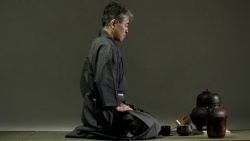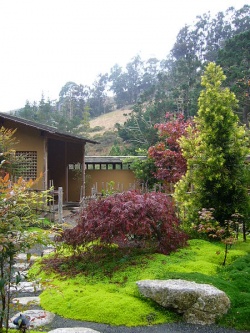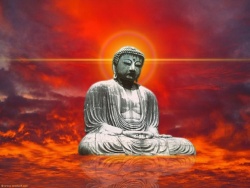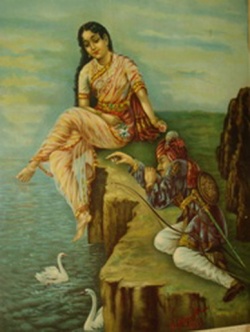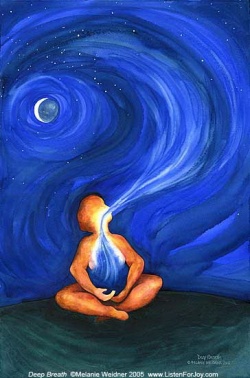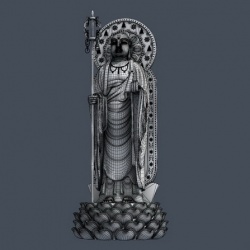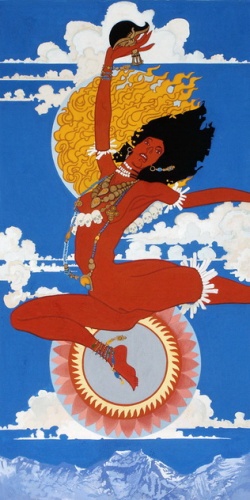Buddhism and the Tea Ceremony
Buddhism and the Tea Ceremony
Written by Venerable Master Hsing Yun
Translated from the Chinese by Irene Poon
China is believed to be the place where tea was first planted; it was dubbed “The Motherland of Tea.” According to Chinese legend, the Divine Cultivator, Shennung, accidentally discovered tea in approximately 2737 BC. He is honored as one of China’s three early, mythical sovereigns, and is also credited with inventing agriculture and herbal medicine. For hygienic reasons he drank only boiled water. One day when Shennung was resting under a wild tea tree, a slight breeze stirred the branches and caused a few leaves to drift gently down into the simmering water that he was preparing. He found the resulting brew deliciously refreshing and revitalizing, and felt it had medicinal value. Tea was discovered!
Chinese historical research has found evidence that tea was used much earlier than previously thought, but tea drinking did not spread widely throughout society until the fifth century. This account is centered on the arrival of Buddhism to China with the 28th Patriarch Bodhidharma of India, the first Patriarch of China. Bodhidharma practiced meditation for nine years while staring at the wall in Songshan Shaolin Temple. According to legend, one day he felt too exhausted to keep his eyes open and fell asleep. To ensure that his eyelids did not droop again he cut them off and tossed them onto the ground. It was a big surprise for him to discover that where his eyelids fell, a tea plant began to grow. Since then, whenever the disciples of Bodhidharma felt tired during meditation, they would pluck some leaves from the tea plant to brew the beverage. Tea was prepared to ignite the vitality and strengthen the will so that the mind could become alert again. Although this is only a legend, it underlines the close relationship between tea and the monks’ daily lives of cultivating enlightenment.
Monastics have busy daily lives and after long hours of sitting meditation it is natural to feel drowsy and distracted. Drowsiness works against effective meditation. Tea is prized for its ability to ignite the vitality and strengthen the will. Tea became the ideal beverage to refresh the mind and to supplement hydration in the body. Thus tea has long been used as a beverage to keep monastics awake and focused during the long hours of deep meditation.
Buddhism has greatly contributed towards the prevalence of tea in Chinese society; in fact, tea first became popularized in temples. Generally, monks and nuns host their lay followers and distinguished guests by serving them tea in the temple. This act influenced the entire civilian population with regards to tea. Gradually, entertaining guests by "offering tea" in homes, in offices, or in restaurants became a popular custom. Furthermore, tea has many effects such as refreshing one’s mind and relieving fatigue resulting from eating greasy food; therefore, so many people have developed the daily habit of “drinking a cup of tea after each meal.” Tea plays a large role in the normal daily life of the Chinese people. There is a Chinese proverb that says, “Firewood, rice, cooking oil, salt, soy sauce, vinegar and tea are the essentials for beginning one’s daily life.” This expression reflects the fact that tea has become a necessary ingredient in Chinese daily life.
Buddhism first came to China from India more than two thousand years ago. Buddhism is readily adaptable to the different cultures of the people who practice it, and it was soon modified to fit the Chinese culture. In China, temples all over the provinces are used for practicing meditation and learning the Dharma, as well as paying respect to the Buddhas and bodhisattvas. For example, the four famous mountains in China with monasteries are Mt. Putuo in Zhejiang province; the Mt. Wutai in Shanxi province; the Mt. Ehmei in Szechuan province and Mount Jiuhua in Anhui province. They are also popularly known as the sacred sites of Avalokitesvara Bodhisattva, Manjusri Bodhisattva, Samantabhadra Bodhisattva and Ksitigarbha Bodhisattva respectively. The traditional Chinese monastery grounds and buildings are constructed in the mountains. There is an old Chinese saying, "Superior tea comes from high mountains," So many of China’s most famous teas come from well-known mountains. In addition to the four famous mountain monasteries mentioned above, there are also Mount Wuyi, Lushan, and Huangshan. Tea is grown best at the highest elevations possible above sea level. That altitude, with its mountain mists, helps protect the plants from excessive sunlight and create the right temperature and humidity necessary for the leaves and buds to develop slowly and to remain tender. Thus, they produce a higher concentration of caffeine, amino acids and essential oils--in light of these conditions, forest monasteries offer the perfect environment for growing tea. Tea plants that have been cultivated in temples are often believed to be the best. Because of this, tea cultivation has grown into a way of life for monastics. In fact, monastics produce the most famous types of tea in the world. For example, Chan Master Baizhang promoted a self-reliant lifestyle that integrated Chan with farming. He was true to his maxim, "A day without work is a day without food." Most Chan monastics followed these rules and devoted a certain amount of their time to daily physical work or to farming. All of this evidence demonstrates the strong connection and close ties that tea has with Buddhism.
Tea, like art, has its schools and its ages. The various methods of appreciating the beverage are indicative of the spirit of the age in which they were developed. This evolution may be roughly divided into three main stages: Boiled Tea (Cake Tea), Whipped Tea (Powdered Tea) and Steeped Tea (Leaf Tea).
According to Jin Shu: Art Biography when Venerable Daokai practiced sitting meditation in the Zhaode Temple during the late Zhao period, he took only a few herbal pills and drank one or two liters of tea concentrate every day. The concentrate was created by boiling together a combination of cake-tea, ginger, cinnamon, orange peel and dates. Eventually he could survive without sleeping or caring about inclement weather.
The Chan School of Buddhism prevailed after the Tang and Song Dynasties. Because most Chan Masters had a high regard for tea drinking, the custom had spread rapidly throughout China. In Volume Six of The Record of what Feng Shi Has Seen and Heard it says, "In the year of Kaiyuan, there was a Chan
Master who exalted the Chan School of Buddhism in the Lingyan Temple of Mount Tai. The Chan Master practiced meditation for many days without eating at night or sleeping, and allowed himself only to drink tea. He boiled tea wherever he was. Henceforth, many civilians learned from him, and imitated each other, and so tea became a favorite beverage among the inhabitants of the society. Tea drinking spread with marvelous rapidity. Gradually, drinking tea became a custom."
Once tea drinking had become a tradition and was popular, in the temples it began to be systematized. In the temples, not only was there a "tea room" where the Chan monks discussed the Dharma, there was also a place to receive the lay followers and distinguished guests. A "tea drum" was located in the northwest corner of the Dharma Hall. The beating of the drum summoned all the Chan monks to the tea room for the tea ceremony. A "tea-chief" or "tea-leader" was responsible for boiling the water, and making and serving the tea. The "giving-tea-monk" served tea and welcomed devotees and visitors at the main entrance of the temple.
The tea served in each temple is usually named after the temple. For example the tea served in Fo Guang Shan Temple is called "Fo Guang Tea." There are also a number of special teas with specific purposes. "Dian Tea" is offered to the Buddhas, bodhisattvas, and patriarchs. "Jiela Tea" is consumed based on the chronological ordination of the fully ordained monastic order. "Pu Tea" is the name of the gathering when all the monastics come together to drink tea.
Typically, monastics arise before dawn. After they prepare for their day, they drink tea and then make prostrations to the Buddha. After each meal, the monks drink a cup of tea before attending to their affairs.
There is a description outlining the daily routine of monastics in Volume 26 of Jingde Record of the Transmission of the Lamp of the North Song Dynasty, written by Venerable Daoyuan: "Monastics usually rise in the morning and, right after cleaning up, they drink tea, and then make prostrations to the Buddha. Before beginning their routine maintenance chores or some particular work, they pay respect to the Abbot in the Dharma Hall. After the noon meal they take a nap. When they awaken from their nap, they refresh themselves by drinking tea before doing work that contributes to the temple’s viability and its function as a center for preserving and passing on the Dharma."
The book, Amalgamation of the Sources of the Five Lamps records that: "Drinking three cups of tea after each meal was the tradition of Chan monks." Hence, drinking tea was an important aspect in a monk’s daily routine, a custom that remains popular and respected to this day.
Cheng Banqiao during the Ching Dynasty wrote the following couplet: "The celebrated scholar expertly judged the choice of water for tea and the boiling temperature. Through the ages, Chan Masters loved tea-tasting contests." Chan Masters in China have been tea-drinkers for many centuries. During the Chan Master’s Tea gatherings many things were discussed: Chan words, personal mind-sets, ways of thinking, and the experience of practicing the way of Chan were all recorded subjects of Chan dialogues. These records, known as Gongans (Koans in Japanese), preserve in written form what the Chan Masters said to their disciples. In these Gongans, there are records of many question and answer sessions between the Chan Masters and their disciples. These records have an apparent simplicity, but they serve to stimulate self–reflection, to challenge the intellect and to satisfy the curious mind. Chan Buddhism inspires one to enlightenment by transcending accepted concepts.
For example, there was a famous Gongan called, "Zhaozhou’s Drinking Tea." Whenever some novices visited Chan Master Zhaozhou and questioned him on how to attain enlightenment, whether through spiritual searching and the way of Chan or through just learning the Dharma, he would simply say, "Go drink some tea, wash the dishes, or sweep the floor." Further questions on how to attain enlightenment or what is Chan or how to practice it would yield the same answer: "Go drink some tea," "wash the dishes," or "sweep the floor." This Gongan demonstrates that we can best experience Chan through living, questioning, and meditating.
Chan is living. We can practice Chan in every aspect of our daily life, whether we are making or drinking tea, washing the dishes, or sweeping the floor. Chan can be found in all aspects of life. Chan Buddhism is not something mysterious, nor is it something profound. The Sixth Patriarch says in the Platform Sutra, "The Dharma lives within the world, enlightenment cannot be attained outside of living." With Chan we approach our daily life through an internal peace of mind and reflect on our true nature. We can attain peace of mind or a spiritual awakening through the most ordinary activities such as drinking tea, eating, and putting on clothes. If we separate meditating from living, we lose touch with reality.
That is why Chan Master Zhaozhou taught us "there is Chan everywhere in our world. If we are separated from life or work, there will be no Chan and it will be impossible to enter the Chan mind." The Gongan "Chan Master Zhaozhou’s drinking tea" influenced the Japanese monks, who carried with them tea drinking practices back to Japan.
Before Japanese Chan Master Murata Shuko became known as the first tea master and founder of the tea ceremony, he was a disciple of Chan Master Ikkyu. He was continually falling asleep during daytime meditation, so he sought a doctor’s advice and was advised to drink tea. Chan Master Murata Shuko grew so fond of tea that he served it to everybody with considerable ceremony. Shogun Yoshimasa heard about this practice and invited Master Murata Shuko to create a tea ceremony for him. Even today, although Japanese scholars cannot agree as to whether a secular tea ceremony existed before this time or not, Chan Master Murata Shuko created Chadou, or Tea Ceremony, in Japan and was dubbed "forefather of the tea art." In Master Shuko’s time, tea drinking became so popular that it was enjoyed by commoners and nobles alike.
After Murata Shuko established the Chadou Master Ikkyu asked him, "What’s your feeling about drinking tea and why do you drink it?"
Master Shuko answered, "I drink tea for health." Master Ikkyu wasn’t satisfied with his answer and asked again, "What is your opinion about 'Zhaozhou’s drinking tea?'"
Master Ikkyu ordered an assistant to serve Shuko a cup of tea, and then he shouted loudly as he slapped the cup of tea from Shuko’s hand and onto the ground. Shuko remained unmoved by Chan Master Ikkyu’s apparently illogical action. Shuko bowed, paid his respects, and said good-bye.
When he reached the door, Master Ikkyu suddenly called his name, shouting, "Shuko!" He turned his head and answered, "Yes Master. Your disciple is here." Chan Master Ikkyu then questioned him, "Since the cup is broken do you still have tea to drink?" Shuko positioned his hands in front of his chest as if he was still holding a cup, pretended to drink tea, and said, "Yes, Master, I am still drinking my tea." Master Ikkyu then asked, "Since you are going to leave, how can you still drink a cup of tea?" Shuko replied sincerely and respectfully, "I am going to drink tea here and there."
Chan Master Ikkyu asked again, "At the beginning of our conversation I asked you, 'what is your feeling when you drink tea?' You answered, 'I drink it for health;' but otherwise you said very little. Now you say you drink tea 'here and there.' What is the point you are trying to make if you have gained nothing from drinking tea?"
Shuko said calmly, "Chan is everywhere in our world, the red flower, the green willow . . . everywhere there is a wonderful world. Similarly, my gaining nothing from the drinking of tea here and there is the space where I can find eternity, the true self, and purity. It is also the real source of the happiness I find in my Chan mind when I go within. Drinking tea creates great peacefulness." As the Master listened to this answer he praised Shuko and handed over complete authority to him so that he could concentrate on the completion of the new Tea Ceremony.
Tea drinking is for spiritual refreshment; it helps us to reach the state of the Chan mind. The tea ceremony encompasses sight, sound, taste, and inner thoughts: just as sitting meditation leads us to the Chan mind, so too does the tea ceremony. As the water splashes into the tea pot as part of the tea ceremony, it acts to cleanse the dust from our minds as we strive to achieve the Chan mind. The ceremony offers four principles: harmony, reverence, purity, and tranquility. The tea experience brings people into harmony with others and with nature and purifies the inner self, leaving other thoughts "outside," and our minds pure. When you awaken you will realize your true nature as being beyond material form. It will be as though you have returned to the original true nature before you were born. The purity and the nature of the tea is a spiritual experience, the same as the Chan mind. While drinking tea you can experience non-self and the state of mind that is beyond taste--If you achieve this state of mind you have reached the superior state of Chan. The true nature and purity of the tea and the Chan mind create and develop tranquility, harmony, and liberty. The experience of the Tea Ceremony and the Chan mind are one and the same.
In the temples in China, the custom of tea drinking spread, and monastics planted tea plants as the custom grew. As time went on, the process of cultivating the tea also became refined. First, the monastics realized that they no longer had to buy their own tea; then they realized that the tea itself could become a small business that would allow them to make a living. As time passed special quality teas became known or became associated with the temples where they were grown.
Since the Ming and Qing Dynasties Buddhist temples have been built deep in the forests and high in the mountains. As a consequence, the environment in the temples was very suitable for growing tea. The monastics pay particular attention to cultivating the tea plants and plucking the tea leaves. The work of processing the tea advanced and the tea became very refined. These temples produced many superior, highly refined teas. This history has given China a reputation for producing many famous teas which people enjoy. Putuo Temple, in Zhejiang province, is famous for their Buddha Tea and its excellent flavor. Another famous tea is Tiantai’s "Cloud and Mist Tea".
It is grown in Huading temple on Mt. Tiantai. Mt. Tiantai is in the eastern Zhejiang province and is the highest of all the peaks of Tiantai Mountain. The tea produced there is an aromatic yellow-green beverage in the higher class of "cloud and mist" teas. In Yunnan province in the city of Dali there is a Gantong Temple, known for "Gantong Tea." This is one of the six major types of tea called Pu Erh tea. Hangzhou’s Dharma Mirror Temple is known for “Fragrant Forest Tea,” which is a green tea that has a very elegant aroma. The most famous tea is from Huiming Temple. It is found halfway up on a peak called Mount Chimu in southern Zhejiang province. In China there are six different types of tea. Many of them simply come from well-known mountains. For example one is called Oolong tea.
This tea was originally grown in Fujian province in the Wuyi Mountains. Wuyi Mountain tea has been grown since the Song Dynasty, with the best Wuyi Montain Tea being grown by the monastics of Wuyi Mountain Temple.
The “Water and Moon Tea” is created by the monastics of the Water and Moon Chan Temple at Mount Dongting. This famous tea goes by the name "Green Snail Spring Tea." It is a famous, aromatic and light green tea. The leaf is rolled during roasting to create a perfect spiral shape that ends up looking like a little snail. It was first grown between the seventeenth and eighteenth centuries in the Dongting Mountains. Harvest time reaches its peak in early April, after which the leaves are no longer at their prime.
The most expensive Chinese tea is called Da Hongpao or "Scarlet Robe." It is grown near the Tianxin Cliff in the Wuyi Mountains of Fujian province. This tea became known because it helped people’s health and gave them long life. When it was grown it was in short supply and high officials and wealthy people came to buy it, driving up the price. The red tea grown in Guiping West Mountain Temple in Guangxi province is a very nice and popular tea. A yellow tea from Mount Huang in Yungu temple called Huangshan Hair Point is grown in Anhui province and is one of the ten best-known teas1 in China. There is a saying about this tea: the first cup is the most fragrant, the second is the sweetest, and the third is the strongest. Overall, most of these famous teas in China are all from Buddhist Temples.
In the Tang Dynasty, Lu Yu was the first man to write a book on tea called The Tea Classics. In Chinese the book was called Cha Jing, and is now known as The Classic Book of Tea. Lu Yu’s interest in tea began in his early life when he brewed it for his foster father, who was a monk. Before Lu Yu (733-804), tea was a rather ordinary drink. But Lu Yu saw nothing ordinary in tea. He traveled to many, many temples to learn about growing, harvesting, processing, categorizing, and brewing tea from the Chan monastics. He was a poet who saw in the tea 1 The ten famous teas include Long Jing (Dragon Well), Bi Luo Chun (Snail Spring), Tie Guan Yin (Iron Goddess), Mao Feng (Fur Peak), Yin Zhen (Silver Needle), Qi Men Hung (Qi Men Red), Da Hung Pao (Big Red Robe), Gua Pien (Melon Seed), Bai Hao Yin Zhen (White Fur Silver Needle), and Pu Erh.
ceremony the same harmony and order that exists in all things. His life was intimately connected to tea and to Buddhism. Not only did he formulate the Code of Tea, but “he taught us to manufacture tea, to lay out the utensils and to brew tea properly.” His book made him famous and he has since been worshipped as the "god of Chinese tea." After Lu Yu, tea became a popular beverage.
In the Song Dynasty in Zhejiang province at the Yuhang Jingshan Temple the monastics, devotees and worshippers would gather together for a tea ceremony. During these tea ceremonies they would have tea-tasting contests. These events evaluate the best quality teas.
Through these activities they modified how tea was made and, over time, the tea-tasting contests changed the methods of making tea. Instead of boiling tea, they began to whip it. The whipped method used powdered tea that was added to hot water and was then whipped with a fine bamboo whisk. This method was used in the Song Dynasty. Changing from boiling tea to whipping it made making tea easier and more convenient and brought tea drinking into greater prominence in mainstream society.
Buddhism spread from China to Korea and as a result tea drinking came into vogue in Korea at the same time.
Around the year 805 the Japanese Monk Saicho went to China to study Buddhism. He went to Guoqing Temple at Mount Tiantai in Zhejiang province.
When he returned to Japan he brought tea seeds back with him. He planted the seeds at Saka Motozon, Loku Daisan Gika Mountain. Five years later, when the plants reached maturity, Abbot Eichu served green tea to Emperor Saga. The emperor was so impressed with the drink that he instituted tea cultivation in provinces near Kyoto, and tea became a part of Japanese life. The Japanese continued to develop the Chinese tea drinking traditions and tea drinking became a complex ritual, with close ties to art.
In 1191 Chan Master Eisai reintroduced tea drinking to Japan. He returned to Japan with more tea seeds and the way of drinking tea at the Chan monasteries. He also brought with him the new powdered green tea. Eisai was strong on tea’s medicinal value and later wrote Japan’s first tea book called Notes on the Curative Effects of Tea. He continued to develop the tea ceremony. Because of Eisai’s efforts tea drinking was popularized and entered into samurai circles.
Chan Masters Seiichi and Dai-O went to the Jingshan Temple in Zhejiang province, bringing back tea seeds, the tea tasting contests, the tea whipping method and the mortar and pestle to turn the tea into powder. They also spread tea drinking throughout the region and popularized the Japanese Tea Ceremony.
Chan Master Shuko was a disciple of Chinese Chan Master Keqin. Before Shuko returned to Japan, his teacher gave him a book called Tea and Chan are One and the Same. Today this book is kept in Nihon Nusa Daitokuji Temple and is still on exhibit there today. Shuko practiced Chan Buddhism and the art of tea by himself and then created the Japanese Tea Ceremony.
From the year 1502 to almost 1600, further advances to the tea ceremony were made by Japanese Chan Master Murata Juko and Tea Master Senno Rikyu. Juko said that he could never achieve peace of mind in a large tearoom. He built an isolated tea hut like a peasant home and because of this he is considered to be the originator of the wabi (jp.) tea ceremony. Rikyu was a pupil of Juko and conducted a tea ceremony for a militarist, Hideyoshi. Rikyu performed the ceremony between warring peoples and stabilized the area. The four principals of the tea ceremony: harmony, respect, purity, and tranquility, were created by Rikyu. His contributions include both the ritual and the philosophy of tea.
The Japanese Tea Ceremony became more famous and formal. The rules around the tea ceremony impacted Japanese literature, the arts, philosophy, calligraphy, flower arrangements, interior design, garden architecture, food preparation and the ritual for greeting one another. Through Buddhism, the Japanese adopted much of the Chinese culture. The Japanese people were able to accept Buddhism through the tea ceremony. Therefore tea became a tool for the spread of the Chan Buddhist tradition.
Since ancient times, Buddhist monastics have planted famous teas, made great tea, and have hosted devotees with tea. Much of today’s tourism centers on serving tea and tea customs. Travelers enjoying sightseeing can become an instant part of the Chinese culture by sharing tea. Tea warms and relaxes them, and they can drink and enjoy all of the different types of famous teas. Centuries ago Chinese ancestors planted tea seeds and today the people of the world enjoy the fruits of generations of labor, love and tradition. Today we appreciate the richness of tea because of the years of devoted energy and effort handed down to us. Now, when you think about tea, or have a cup of tea, you can sit down and relax and forget your problems. With tea, troubles just drift away. Get together with old friends in a comfortable place where you can share ideas from business and from life and enjoy some tea. The place where tea is served is a place of peace and harmony. Tea gives you a special tranquility and offers you a chance to purify your mind and it leads you to discover the Chan mind. Tea is very good company in our lives.
